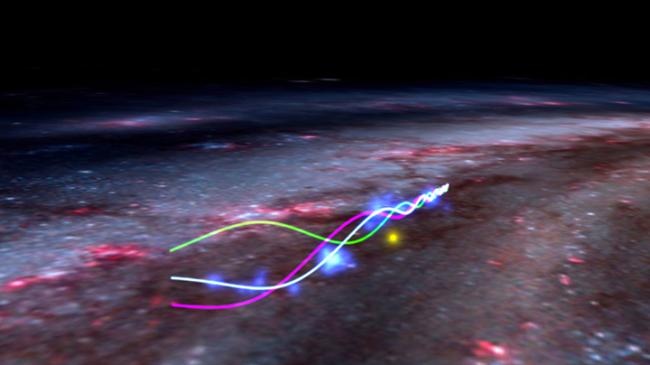
In the Milky Way, not far from our sun, lies a colossal chain of gas clouds. It's called the Radcliffe Wave. Some 800 million stars live within the Radcliffe Wave, and the wave's star-forming gas is even now seeding hundreds of millions more.
As you may imagine, the astronomers who discovered the Wave named it as such because it looked like a "wave" to them — and in a new paper, some of the same astronomers now present evidence that it is also a literal wave. It oscillates over time, they realized, its stars rising through the Milky Way's disk before falling back again.
"By using the motion of baby stars born in the gaseous clouds along the Radcliffe Wave," Ralf Konietzka, a graduate student at Harvard and the paper's lead author, said in a statement, "we can trace the motion of their natal gas to show that the Radcliffe Wave is actually waving."
Related: Very Large Telescope snaps gorgeous shot of Milky Way's star-studded core (photo)
The Radcliffe Wave is the largest single structure of gas known to astronomy. It is up to 400 light-years deep and 9,000 light-years long, undulating nearly a tenth of the way across the Milky Way's diameter. At its closest to us, the wave is just 500 light-years away. Astronomers discovered it several years ago when they mapped our galaxy's dust.
However, what they had not done at the time was look at how stars within the Wave were moving. They didn't know what direction the bodies were headed toward and how quickly they were headed there. Now, they have completed that puzzle using data from the European Space Agency's Gaia spacecraft. And when they did, they found clusters in the Wave rose and fell in a pattern that propagated across the galaxy like a ripple.
Learning more about the Wave can tell us more about how our galaxy operates. For instance, astronomers found that the entire Wave is radiating away from the galaxy's center. This suggests the stars that forged the Local Bubble, a cavity in the interstellar gas around our solar system that likely blew out from supernovas between 10 and 20 million years ago, may have originated in the Radcliffe Wave.
Breaking space news, the latest updates on rocket launches, skywatching events and more!
The team’s research was published in the journal Nature on Feb. 20.

Rahul Rao is a graduate of New York University's SHERP and a freelance science writer, regularly covering physics, space, and infrastructure. His work has appeared in Gizmodo, Popular Science, Inverse, IEEE Spectrum, and Continuum. He enjoys riding trains for fun, and he has seen every surviving episode of Doctor Who. He holds a masters degree in science writing from New York University's Science, Health and Environmental Reporting Program (SHERP) and earned a bachelors degree from Vanderbilt University, where he studied English and physics.
